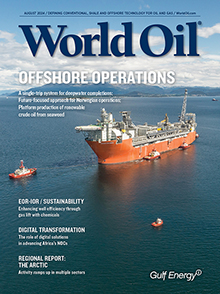Issue: August 2024
SPECIAL FOCUS: Offshore operations
A new multi-zone single trip system with an integrated barrier valve offers a comprehensive solution for offshore deepwater and ultra-deepwater sand-control completion needs.
Learn how a collaborative approach enables operators to meet immediate maintenance requirements in addition to future needs, unlocking reliability, efficiency, and other benefits.
Seaweed biomass from the ocean can be converted to bio-crude oil to supplement declining output from depleting oil fields. The process may extend production platforms’ useful lives. It also can control sargassum blooms in the Atlantic, while providing bio-crude oil to U.S. refineries, as feedstock.
Features
When integrated as part of a cross-functional solution encompassing the downhole tool design, chemical delivery method, and automated gas injection rate controls, chemical packages qualified for the job at hand can help operators get the most out of their wells while ensuring long-term gas lift system operation.
Learn how orphaned wells came to be in the U.S. and how specific stakeholders can participate in well plugging initiatives made possible by federal, state and Tribal grant program funding.
Part 1: Since 1929, the Independent Petroleum Association of America (IPAA) has advocated for, protected and defended thousands of independent producers. As the association nears its 95th Annual Meeting in October, this first of two articles examines its initial 65 years.
Digitalization is set to revolutionize African national oil companies (NOCs) by overcoming infrastructural, regulatory, and political challenges. By investing in tailored digital solutions and developing local talent, NOCs can significantly boost efficiency, decision-making, and production, contributing to their nations' economic progress.
Arctic oil and gas investments are shaped by a dynamic interplay of regulatory approvals, geopolitical factors, and stringent environmental safeguards, with future developments contingent on political outcomes and market adaptations to environmental and energy transition pressures.
Discover how digitalization drives efficiency and sustainability in the upstream oil and gas industry. This article introduces insights and solutions for companies by showcasing a real-world use case that demonstrates the practical applications of digital transformation in saving energy and emissions.
In the belief that its growth and ability to gain market share are tied in with technology, Oil States has pursued a deliberate path of technical innovation that has seen the firm win seven OTC Spotlight on New Technology awards in recent years.
The rate of drilling and production among operators in Federal Reserve District 11 during the second quarter remained little changed from the first quarter. Amid regulatory uncertainty and unpredictable economics, companies are biding their time until the U.S. election.
Columns
It was refreshing to attend two very different trade shows during this month and come away with a sense of optimism from the attendees at both of them. It’s easy to be pessimistic about the U.S. market, since it has been flat more most of 2024, and wonder whether international and offshore activity can carry the day.
With hydraulic fracturing, especially in unconventional wells, the industry has moved to the “well factory” approach. I used to call that the “cookie cutter” approach, which in my mind is the same thing, but as with many (or all) industries, terminology is developed to paint a positive picture or even one suggesting advancing technology rather than stagnation.
Europe proceeds on the path to net zero carbon emissions, joined by post-Brexit UK. Not going to meet 2030 emission targets, the EU Commission doubles down, setting stricter targets for 2040. Post-Brexit UK intends to phase out all fossil fuel use by 2050.
This week in Midland, Texas, the Produced Water Society (PWS) held their annual Permian Basin Conference and, as usual, the topics and discussion didn’t disappoint. One of the most covered topics was the desalination of produced water and the potential uses from discharge to beneficial reuse.
In recent years, the global energy landscape has undergone a seismic shift. From the pre-pandemic era of "energy duality," which emphasized both affordable and cleaner energy, we have navigated through the turbulence of the pandemic and geopolitical upheavals, such as the conflict in Ukraine.
Oil prices rose slightly again in July, following lower final numbers for June’s prices. Future compiled prices for August were predicted to be lower, however.



